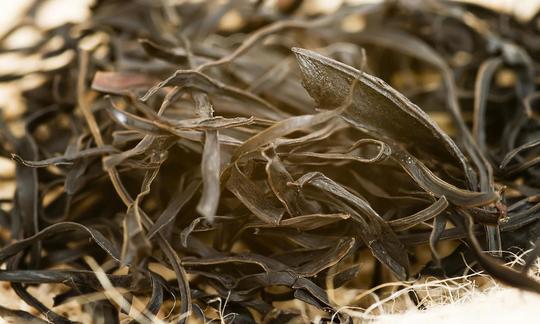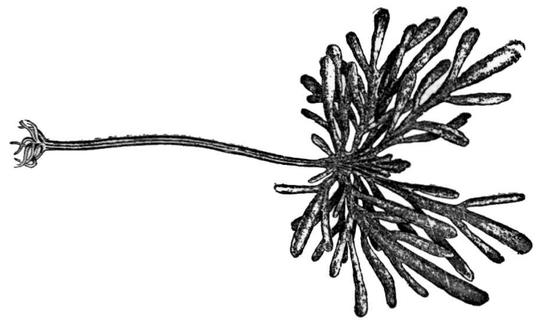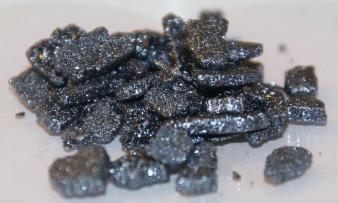Table of contents
Arame ( Eisenia bicyclis ) is a brown seaweed that is particularly popular in Japanese and Korean cuisine. It tastes particularly good raw in salads and cooked in soups. Organic?
Use in the kitchen
The brown algae Arame is characterized by a delicate, spicy, particularly mild taste and is therefore also suitable for "algae beginners". Dried Arame algae are usually cut into thin strips and look like black soup noodles - whether these are raw food quality depends on the drying method used. Before preparation, they should be cleaned under running water and soaked in cold water for about 15 minutes.
Arame can be enjoyed raw, cooked or fried. Arame seaweed is mainly used in East Asian cuisine, where it is often eaten in soups and salads. 1 Arame tastes particularly good in miso , but also in pumpkin soups (e.g. with butternut squash ). The seaweed can be used in many different salads, e.g. in a spinach salad with tofu , radishes and spring onions in a Japanese dressing (with rice vinegar , soy sauce ), in a quinoa salad with kidney beans , avocado and rocket or in a green bean salad with tomatoes and olives . Carrot , cucumber and cabbage salads (e.g. red cabbage salad with a tahini dressing) can also be wonderfully spiced up with arame.
Arame seaweed also enriches all kinds of vegetarian or vegan rice dishes (e.g. sticky rice with shiitake mushrooms , sugar snap peas , carrots in soy sauce and mirin, or stir-fry vegetables with pak choi served with basmati rice ) and noodle dishes (e.g. soba noodles with sauerkraut ,corn , spring onions in tahini and lemon juice ). Arame also works well in a risotto (e.g. with mushrooms and peas ).
Kinpira is both a cooking method (a combination of sautéing and simmering) and a typical Japanese side dish that is mainly made from root vegetables such as salsify , carrots or lotus roots. However, this vegan side dish can also be made with arame (see the following recipe).
Vegan recipe for Arame Kinpira
Ingredients (for 4 people): 16 g Arame (dried, preferably organic), 2 onions , 4 carrots, 1 spring onion, 2 tsp sesame oil , 2-3 tsp tamari .
Preparation: Put the dried arame seaweed in a bowl and cover with water. Leave to swell for about 15 minutes, then drain the water. Peel the onions, halve them and cut them into half rings. Rinse the carrots, halve them and cut them into fine strips (julienne). Cut the green part of the spring onion into rings. Heat the pan with sesame oil over medium heat. Add the onion half rings and fry for about 2 minutes. Add the carrot julienne and fry for another 2 minutes. Add arame and drizzle a little water over it. Mix everything together well, put the lid on the pan and reduce the heat. Simmer for about 3 minutes, then season with tamari. Put in small bowls and garnish with spring onion rings. This vegan, Japanese side dish goes well with sushi dishes, rice, soup or fresh bread.
Vegan recipes with Arame can be found under the note: " Recipes that have the most of this ingredient ".
| Not only vegans or vegetarians should read this: Vegans often eat unhealthily. Avoidable nutritional mistakes . |
Purchasing - Storage
Arame is rarely available fresh in Europe. You can find dried Arame seaweed cut into strips in Asian grocery stores or online shops, even in organic quality. Supermarkets (e.g. Coop , Migros , Denner , Volg , Spar , Aldi , Lidl , Rewe , Edeka , Hofer , Billa ) and organic supermarkets (e.g. Denn's Biomarkt , Alnatura ) generally do not sell the seaweed.
The availability of Arame varies depending on the size of the store, catchment area, etc. Our recorded food prices for the DA-CH countries can be found above under the ingredient image - and by clicking you can see their development at various suppliers.
Storage tips
Dried arame leaves are best stored in an airtight container in a dry place protected from light. This way they will last for several years. Fresh seaweed should be kept in the refrigerator and used within a few days.
Ingredients - Nutritional values - Calories
The energy content of Arame (raw) is 43 kcal and is therefore low. With 0.56 g/100g fat, the seaweed is also low in fat. It contains 9.6 g/100g of carbohydrates and 1.7 g/100g of proteins. The salt content is relatively high at 592 mg/100g (24.7% of the daily requirement). Raw wakame (2,215 mg/100g), nori leaves (3,439 mg/100g) and dried kombu seaweed (7,112 m/100g) contain even more salt, which is too much. 2
The iodine content of arame is high, averaging 70,000 µg/100g dry weight. 3 The iodine content of fresh arame is likely to be around 8,750 µg/100g, if calculated based on the difference in water content. Seaweed is generally rich in iodine, for example dried dulse has 7,500 µg/100g, raw laminaria seaweed 38,000 µg/100g and dried kombu seaweed 295,400 µg/100g. 2 The iodine content of seaweed can vary considerably depending on the region where it is grown, how it is stored and how it is processed. Read more about iodine in the chapter "Danger - Intolerances - Side Effects".
Raw arame seaweed is rich in folate (ex vitamin B 9 , B 11 ) . The content of 180 µg/100g (90% of the daily requirement) is similar to that of bladderwrack (180 µg/100g), laminaria seaweed (kelp; 180 µg/100g) and cartilage kelp (182 µg/100g). Raw wakame has a little more at 196 µg/100g and dried dulse (ragweed) has about seven times as much vitamin at 1,269 µg/100g. 2
Vitamin K is also present in considerable quantities at around 66 µg/100g (88% of the daily requirement). Bladderwrack (66 µg/100g) and Laminaria algae (66 µg/100g) contain similar amounts. Swiss chard contains much more vitamin K (830 µg/100g). 2
The complete ingredients of Arame (raw), the coverage of the daily requirement and comparison values with other ingredients can be found in our nutrient tables. In the article Nutrients explained you will get a detailed insight into the topic.
Health effects
The main bioactive compounds identified in arame ( Eisenia bicyclis ) are phenolic compounds such as phlorotannins (e.g. eckol), polysaccharides (e.g. laminarin, fucoidan) and carotenoids (e.g. fucoxanthin). 1,4 They possess a wide range of pharmacological activities such as antioxidant, anti-inflammatory, anticancer, neuroprotective, antiviral and antidiabetic. 1, 5,7
Eisenia bicyclis inhibits the formation of thrombi, thus showing therapeutic potential for use as an antiplatelet and antithrombotic agent to prevent cardiovascular disease. 6 Arame extracts can also lower cholesterol levels and help prevent hypercholesterolemia, the main risk factor for cardiovascular disease. 4
In addition, due to its significant calcium content, Arame algae stimulates bone calcification and has anti-allergic properties that can be attributed to the presence of phlorotannins. 5
The results of a 2021 study showed the photoprotective effect of an extract from Eisenia bicyclis , which can prevent UVB-induced skin damage. 7
Dangers - Intolerances - Side effects
Arame algae and seaweed in general are a source of the essential trace element iodine . This plays an important role in thyroid function, as it is required for the synthesis of thyroid hormones. However, long-term, high intake of iodine is problematic and can lead to thyroid dysfunctions such as hyperthyroidism or hypothyroidism.
The recommended iodine intake is 150 μg/day for adults. The Scientific Committee on Food (SCF) has set a maximum tolerable amount of 600 μg/day. The amount of brown algae biomass that corresponds to a certain amount of iodine varies greatly. Processing processes (e.g. drying) can significantly reduce the iodine content of brown algae, but the iodine content is still high afterwards. The stated maximum daily amount of iodine for adults (600 μg) can be achieved by consuming 0.2-11 g of processed, dry brown algae. 3 Therefore, only consume brown algae, including arame, in small quantities and when buying algae products, make sure that the iodine content and a maximum recommended daily intake are stated. This will enable you to estimate how high your iodine intake is and avoid over-consumption.
Ecological footprint - animal welfare
Algae generally have an excellent carbon footprint because they remove CO₂ from the atmosphere, which is good for the climate. According to researchers at the Max Planck Institute for Marine Microbiology in Bremen, brown algae absorb large amounts of carbon dioxide from the air and release some of the carbon it contains back into the environment in the form of mucus. Since the algae mucus, called fucoidan, is difficult for other marine creatures to break down, the carbon remains bound in it and does not return to the atmosphere for a long time. The researchers estimate that brown algae could remove up to 550 million tons of carbon dioxide from the air every year. 8
Seaweed is theoretically capable of mitigating climate change. Despite some limitations, products made from seaweed have the potential to increase carbon sequestration and reduce greenhouse gas emissions. Compensating foods with high carbon and water footprints using macroalgae could have great potential in the area of climate protection. However, this positive effect depends on the actual implementation of the algae farms. 10, 11
Brown algae are ecologically important. You could even call them ecosystem engineers: they create habitat for other marine life and balance the climate. Due to stress factors such as climate change and pollution, stocks could decline. Bridging the gap between use and conservation or restoration is therefore an important research topic. 12
Worldwide distribution - cultivation
The brown alga Arame occurs along the central Pacific coasts of China, Korea and Japan. 4.7
Arame is similar in taste and especially in appearance to the brown seaweed Hijiki ( Sargassum fusiforme ). However, Arame is softer in consistency and milder in taste.
Cultivation - Harvesting
Arame is primarily collected from natural stocks. It is usually harvested by hand and dried in the sun before being cut into fine strips.
The wild collection of algae can be carried out according to organic standards. It is important to ensure that the water used for collection is clean. Collected organic algae therefore come from waters far from busy ports, sewage discharges, nuclear power plants, conventional aqua farms or other sources of pollution. It is also important to harvest sustainably, i.e. only take as much as can grow back. Stocks must be maintained so that other marine life is not harmed by the harvest. 9
Further information
The alga Arame ( Eisenia bicyclis ) belongs to the Lessoniaceae family within the brown algae order Laminariales.
Also read our articles on other brown seaweeds such as bladderwrack , kombu seaweed (dried) , laminaria seaweed ( Laminari a spp.) and wakame , and on red seaweeds (kelp) such as kelp , dulse (dry) and nori sheet .
Alternative names
Arame, occasionally also written Aramé, is also known as sea oak or sea oak. 5 However, these names are also used for the brown algae bladder wrack . Incorrect spellings such as Ara me, Aramr, Aramw creep in.
In English, Arame is called arame, arame alga, arame algae or sea oak.
Ecklonia bicyclis is a synonym for the Latin name Eisenia bicyclis .
Other applications
The algae is used for the industrial production of sodium alginate, which is used as a gelling and thickening agent. 1










Comments